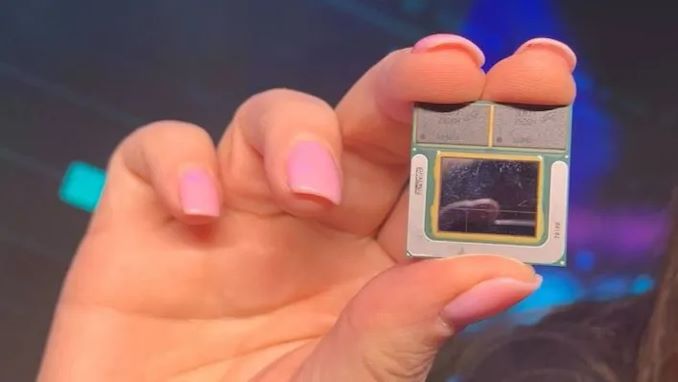Intel Teases Lunar Lake At Intel Vision 2024: 100+ TOPS Overall, 45 TOPS From NPU Alone
by Gavin Bonshor on April 11, 2024 1:00 PM EST- Posted in
- CPUs
- Intel
- Mobile
- NPU
- AI
- Intel 18A
- Lunar Lake
- Intel Vision 2024
- AI PC

During the main keynote at Intel Vision 2024, Intel CEO Pat Gelsinger flashed a completed Lunar Lake chip off, much like EVP and General Manager of Intel's Client Computing Group (CCG) Michelle Johnston Holthaus did back at CES 2024. The contrast between the two glimpses of the Lunar Lake chip is that Pat Gelsinger gave us something juicier than just a photo op. He clarified and claimed the levels of AI performance we can expect to see when Lunar Lake launches.
According to Intel's CEO Pat Gelsinger, Lunar Lake, scheduled to be launched towards the end of this year, is set to raise the bar even further regarding on-chip AI capabilities and performance. At Intel's own Vision event, aptly named Intel Vision, current CEO of Intel Pat Gelsinger stated during his presentation that Lunar Lake will be the 'flagship SoC' for the next generation of AI PCs. Intel claims that Lunar Lake will have 3X the AI performance of their current Meteor Lake SoC, which is impressive as Meteor Lake is estimated to be running around 34 TOPS combined with the NPU, GPU, and CPU.
Factoring in the NPU within Meteor Lake, 11 of the 34 TOPS come solely from the NPU. Still, Intel claims that the NPU on Lunar Lake will hit a large 45 TOPs, akin to the Hailo-10 add-in card and similar to Qualcomm's Snapdragon X Elite processor. Factoring in the integrated graphics and the compute cores, Intel is claiming a combined total of over 100 TOPS, and with Microsoft's self-imposed guidelines of what constitutes an 'AI PC' coming in at 40 TOPS, Intel's NPU fits the bill.
Intel also alludes to how they are gaining a load of TOPS performance from the NPU, whether that be with new technologies; the NPU will likely be built in a more advanced node, perhaps Intel 18A. Another thing Intel didn't highlight was how they were measuring the TOPS performance, whether that be INT8 or INT4.
Still, one thing is clear: Intel wants to increase on-chip AI capabilities in desktop PCs and notebooks with each generation. Intel is also attempting to leverage more AI performance to help boost its goal to ship 100 million AI PCs by the end of 2025. Intel has already announced that it's shipped 5 million thus far and plans to sell another 40 million units by the end of the year.











14 Comments
View All Comments
m53 - Thursday, April 11, 2024 - link
Lunar Lake seems to be a massive improvement over Meteor Lake. New node, new architecture, on package memory. Massive performance improvement. Also the on package memory should help with efficiency improvements just like it did with M1. Very eager to see it in the market.Orfosaurio - Thursday, April 11, 2024 - link
This!Dolda2000 - Saturday, April 13, 2024 - link
I can't exactly say that memory-on-package is a development that exactly excites me with its intrinsic non-upgradability. I sure hope they get some serious efficiency gains from it to make up for such shortcomings. It would be very interesting to see its efficiency compared to a reasonably comparable non-MoP processor.hubick - Friday, April 12, 2024 - link
I hate these bandwagons. I don't want an AI PC any more than I want a Blockchain PC. Just sell me a Thunderbolt 5 PC... that's technology I actually do want.GeoffreyA - Friday, April 12, 2024 - link
Indeed, the AI PC made me shake my head. The companies are tripping over themselves, desperate to grab those dollars from the AI pot.Threska - Friday, April 12, 2024 - link
Games will have better AI.GeoffreyA - Friday, April 12, 2024 - link
I suppose if we could go back to the '90s and imagine a "3D PC" that ran 3D applications and sported a Voodoo graphics card, it would be analogous to what the AI PC concept is trying to push.mode_13h - Wednesday, April 17, 2024 - link
An even older throwback: "Multimedia PC"I remember when "multimedia" was a buzzword, back in the mid-90's. I was never exactly sure what it meant, but I guess it basically covered PCs with CD-ROM drives, sound cards, and the ability to do some amount of "full-motion video" playback.
GeoffreyA - Wednesday, April 17, 2024 - link
Indeed, I remember the "Multimedia PC" and how software also played a part. My "1996 Grolier Multimedia Encyclopedia" came on a CD-ROM, and made much of its 8-bit images, video clips, and sounds; QuickTime had to be installed for the multimedia to work. I remember the endless Microsoft trial versions full of sound and video. And my graphics card was ATI's Rage II+ DVD, because it had iDCT acceleration (rather than full MPEG-2).mode_13h - Wednesday, April 17, 2024 - link
Impressive recall! I never had a CD-ROM encyclopedia, but I think that was probably the most popular one. I didn't jump on the "video playback card" bandwagon. However, around 1999 I got a Rage 3D and picked up a few Video CDs to test out its full-screen playback prowess.